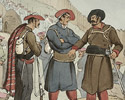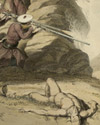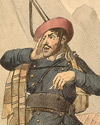19th Century´s militar history in the Basque Country
The carlist infantry
 When the war broke out in October 1833, there was no Carlist army as such, since it was an insurrection led by groups of soldiers from the Royalist Militias, which were in the process of being dissolved by government measures, and a few hundred poorly-armed farmers led by officials who had been left without posts after the military purgings carried out at the end of the reign of Ferdinand VII.
When the war broke out in October 1833, there was no Carlist army as such, since it was an insurrection led by groups of soldiers from the Royalist Militias, which were in the process of being dissolved by government measures, and a few hundred poorly-armed farmers led by officials who had been left without posts after the military purgings carried out at the end of the reign of Ferdinand VII.
Carlist soldiers fighting in Basque territory were always far fewer than their enemies in the Liberal infantry. Although it is difficult to calculate exact figures because of the significant fluctuations, Don Carlos had approximately 16,000 soldiers when he arrived at the battle scene in July 1834, compared to the 35,000 men who made up the Carlist army after 1836.
Much has been written on the volunteer nature of the Carlist troops. While this may have been true during the first phase of the war, when the troops were led by Zumalacárregui, diverse orders for general recruitment and the many ordinances to prevent desertion, published after the arrival of the Pretender, confirm the difficulties experienced by Carlist authorities in maintaining the discipline of their troops. This problem was aggravated by the duration of the conflict. It is also true that many Liberal deserters crossed over to Carlist lines.
At the outbreak of war, the main problem for the Carlists concerned the obtaining of arms and supplies for volunteers. Their main strategy was to assault Liberal convoys and recover spoils from their victories, along with what they could obtain through contraband with France. The following excerpt written by the Austrian volunteer Schwazenberg, illustrates the Carlist shortages,
 "The Basque battalions had generally become very skilful at pillaging the dead. Even the most skilful valet would be no match for them. After the combat, a waiting period was required to give the soldiers time to get dressed before meeting. All they left the English were their black bow ties and socks, which were useless to the Carlists, as they did not wear them. It was quite a macabre scene with those dead bodies wearing no other clothes than their socks and ties."
"The Basque battalions had generally become very skilful at pillaging the dead. Even the most skilful valet would be no match for them. After the combat, a waiting period was required to give the soldiers time to get dressed before meeting. All they left the English were their black bow ties and socks, which were useless to the Carlists, as they did not wear them. It was quite a macabre scene with those dead bodies wearing no other clothes than their socks and ties."
 In contrast to the heavy and uncomfortable equipment of the Liberal army, Zumalacárregui adapted to the circumstances by encouraging the use of canvas sacks instead of rucksacks and adopted the use of berets instead of helmets, which would later become the characteristic trait of the Carlist troops. He also organised his men into battalions, which contained fewer men than the Liberal regiments and were hence easier to manoeuvre and command.
In contrast to the heavy and uncomfortable equipment of the Liberal army, Zumalacárregui adapted to the circumstances by encouraging the use of canvas sacks instead of rucksacks and adopted the use of berets instead of helmets, which would later become the characteristic trait of the Carlist troops. He also organised his men into battalions, which contained fewer men than the Liberal regiments and were hence easier to manoeuvre and command.
After consolidation of the Northern Carlist army, the infantry was organised into divisions by their geographical origin. In 1839, the Navarre Division had 13 battalions, the Alava Division had 7, the Guipuzcoa Division, 8, the Vizcaya Division, 9, the Cantabria Division had 3, and the Castile Division had 4 battalions.

